A soap bubble of radius R = 3 cm and thickness t=10−2 mm is charged to a potential of V = 0.3 volt. The bubble burst and falls as a spherical drop. Determine the potential of the drop
3 volts.
6 volts
9 volts
12 volts.
The correct Answer is:A
To solve the problem, we need to determine the potential of a soap bubble after it bursts and becomes a spherical drop. We will use the principles of electrostatics and the conservation of charge.
1. Identify Given Values:
- Radius of the soap bubble, R=3cm=0.03m
- Thickness of the soap bubble, t=10−2mm=10−5m
- Initial potential of the bubble, V=0.3V
2. Calculate the Charge on the Bubble:
The charge Q on the soap bubble can be calculated using the formula for the potential of a spherical conductor:
V=Q4πϵ0R
Rearranging this gives:
Q=V⋅4πϵ0R
Substituting the known values:
Q=0.3⋅4π⋅(8.854×10−12)⋅0.03
3. Calculate the Charge Q:
First, calculate 4πϵ0:
4πϵ0≈4⋅3.14⋅(8.854×10−12)≈1.112×10−10C/V
Now substituting this into the charge equation:
Q=0.3⋅1.112×10−10⋅0.03≈1.003×10−12C
4. Determine the Radius of the Droplet:
When the bubble bursts, it becomes a solid spherical drop with the same volume of soap. The volume of the soap bubble is given by:
Vbubble=43π(R3−(R−t)3)
The volume of the drop is:
Vdrop=43πr3
Since the volume of the soap remains constant, we can set these equal:
43π(R3−(R−t)3)=43πr3
Simplifying gives:
R3−(R−t)3=r3
5. Calculate r:
Expanding (R−t)3:
(R−t)3=R3−3R2t+3Rt2−t3
Therefore:
R3−(R3−3R2t+3Rt2−t3)=r3
Simplifying gives:
3R2t−3Rt2+t3=r3
For small t, we can neglect t3:
r3≈3R2t
Substituting R=0.03m and t=10−5m:
r3≈3(0.03)2(10−5)=3⋅0.0009⋅10−5=2.7×10−8
Thus:
r≈(2.7×10−8)1/3≈0.029m≈2.9cm
6. Calculate the Potential of the Droplet:
Using the formula for potential again:
V′=Q4πϵ0r
Substituting Q and r:
V′=1.003×10−124π(8.854×10−12)(0.029)
Calculate V′:
V′≈1.003×10−123.27×10−12≈0.306V
This is approximately 3V.
Final Answer:
The potential of the drop is approximately 3 volts.
- Radius of the soap bubble, R=3cm=0.03m
- Thickness of the soap bubble, t=10−2mm=10−5m
- Initial potential of the bubble, V=0.3V
The charge Q on the soap bubble can be calculated using the formula for the potential of a spherical conductor:
V=Q4πϵ0R
Rearranging this gives:
Q=V⋅4πϵ0R
Substituting the known values:
Q=0.3⋅4π⋅(8.854×10−12)⋅0.03
First, calculate 4πϵ0:
4πϵ0≈4⋅3.14⋅(8.854×10−12)≈1.112×10−10C/V
Now substituting this into the charge equation:
Q=0.3⋅1.112×10−10⋅0.03≈1.003×10−12C
When the bubble bursts, it becomes a solid spherical drop with the same volume of soap. The volume of the soap bubble is given by:
Vbubble=43π(R3−(R−t)3)
The volume of the drop is:
Vdrop=43πr3
Since the volume of the soap remains constant, we can set these equal:
43π(R3−(R−t)3)=43πr3
Simplifying gives:
R3−(R−t)3=r3
Expanding (R−t)3:
(R−t)3=R3−3R2t+3Rt2−t3
Therefore:
R3−(R3−3R2t+3Rt2−t3)=r3
Simplifying gives:
3R2t−3Rt2+t3=r3
For small t, we can neglect t3:
r3≈3R2t
Substituting R=0.03m and t=10−5m:
r3≈3(0.03)2(10−5)=3⋅0.0009⋅10−5=2.7×10−8
Thus:
r≈(2.7×10−8)1/3≈0.029m≈2.9cm
Using the formula for potential again:
V′=Q4πϵ0r
Substituting Q and r:
V′=1.003×10−124π(8.854×10−12)(0.029)
Calculate V′:
V′≈1.003×10−123.27×10−12≈0.306V
This is approximately 3V.
The potential of the drop is approximately 3 volts.
Topper's Solved these Questions
- BOOK - FIITJEECHAPTER - PHYSICS PART2EXERCISE - Section (I) : Subjective4videos
PHYSICS PART2
- BOOK - FIITJEECHAPTER - PHYSICS PART2EXERCISE - Section (II) : MCQ27videos
PHYSICS PART2
- BOOK - FIITJEECHAPTER - PHYSICS PART-IIIEXERCISE - NUMERICAL BASED QUESTIONS DECIMAL TYPE11videos
PHYSICS PART-III
- BOOK - FIITJEECHAPTER - ROTATIONAL MECHANICSEXERCISE - COMPREHENSION - IV2videos
ROTATIONAL MECHANICS
Similar Questions
A conducting liquid bubble of radius a and thickness t(t<<a) is charged to potential V. If the bubble collapses to a droplet , find the potential on the droplet .
View SolutionA conducting liquid bubble of radius a and thickeness t(t<<a) is charged to potenital V. If the bubble collapses to a droplet , find the potential on the droplet .
View Solution
Knowledge Check
- Question 1 - Select One
27 identical drops, each charged to potential 10 volts, combined to form a bigger drop. Find potential of this bigger drop ?
A148VB90VC180 VD127V - Question 2 - Select One
8 equally charged drops are combined to form a big drop. If the potential on each drop is 10 V, then the potential of the big drop will be
A40 VB30 VC25 VD20 V - Question 3 - Select One
A soap bubble is charged to a potential of 16V. Its radius is then doubled. The potential of the bubble now will be
A16VB8VC4VD2V
512 identical drops of mercury are charged to a potential of 2V each. The drops are joined to form a single drop. The potential of this drop is ___ V.
View SolutionThere are 27 drops of a conducting fluid. Each drop has radius r, and each of them is charged to the same potential V1. They are then combined to from a bigger drop. The potential of the bigger drop is V2. Find the ratio V2/V1. Ignore the change in density of the fluid on combining the drops.
View Solution27 spherical drops, each carrying a charge of 10−3μC that are at potential of 1,000 volts are combined to form a bigger drop. What would be the potential of this bigger drop?
View SolutionA soap bubble has radius R and thickness d(<<R) as shown. It collapses into a spherical drop. The ratio of excess pressure in the drop to the excess pressure inside the bubble is
 View Solution
View SolutionN small conducting liquid droplets, each of radius r, are charged to a potential V each. These droplets coalesce to form a single large drop without any charge leakage. Find the potential of the large drop.
View Solution

